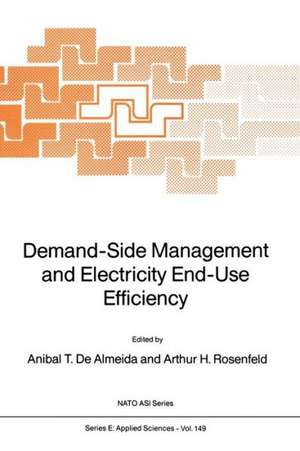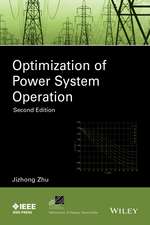Demand-Side Management and Electricity End-Use Efficiency: NATO Science Series E:, cartea 149
Editat de A. de Almeida, Arthur H. Rosenfelden Limba Engleză Paperback – 28 oct 2011
Din seria NATO Science Series E:
- 24%
 Preț: 1570.65 lei
Preț: 1570.65 lei -
 Preț: 397.76 lei
Preț: 397.76 lei -
 Preț: 386.81 lei
Preț: 386.81 lei - 20%
 Preț: 346.24 lei
Preț: 346.24 lei -
 Preț: 424.33 lei
Preț: 424.33 lei - 18%
 Preț: 1224.18 lei
Preț: 1224.18 lei - 18%
 Preț: 1836.63 lei
Preț: 1836.63 lei - 18%
 Preț: 1229.28 lei
Preț: 1229.28 lei -
 Preț: 381.00 lei
Preț: 381.00 lei -
 Preț: 409.30 lei
Preț: 409.30 lei - 18%
 Preț: 1841.36 lei
Preț: 1841.36 lei - 5%
 Preț: 367.28 lei
Preț: 367.28 lei -
 Preț: 407.19 lei
Preț: 407.19 lei - 18%
 Preț: 1838.38 lei
Preț: 1838.38 lei -
 Preț: 420.28 lei
Preț: 420.28 lei -
 Preț: 399.29 lei
Preț: 399.29 lei -
 Preț: 398.74 lei
Preț: 398.74 lei - 18%
 Preț: 3026.13 lei
Preț: 3026.13 lei -
 Preț: 388.90 lei
Preț: 388.90 lei - 5%
 Preț: 391.06 lei
Preț: 391.06 lei - 18%
 Preț: 1228.62 lei
Preț: 1228.62 lei - 18%
 Preț: 1229.73 lei
Preț: 1229.73 lei - 18%
 Preț: 1234.46 lei
Preț: 1234.46 lei - 5%
 Preț: 3532.05 lei
Preț: 3532.05 lei - 18%
 Preț: 1840.11 lei
Preț: 1840.11 lei - 5%
 Preț: 378.80 lei
Preț: 378.80 lei - 18%
 Preț: 1227.84 lei
Preț: 1227.84 lei -
 Preț: 392.75 lei
Preț: 392.75 lei -
 Preț: 395.63 lei
Preț: 395.63 lei - 18%
 Preț: 2489.30 lei
Preț: 2489.30 lei - 5%
 Preț: 1429.27 lei
Preț: 1429.27 lei -
 Preț: 396.02 lei
Preț: 396.02 lei - 5%
 Preț: 2142.61 lei
Preț: 2142.61 lei - 18%
 Preț: 3049.16 lei
Preț: 3049.16 lei - 18%
 Preț: 1844.54 lei
Preț: 1844.54 lei -
 Preț: 403.53 lei
Preț: 403.53 lei
Preț: 409.30 lei
Nou
Puncte Express: 614
Preț estimativ în valută:
78.32€ • 81.99$ • 64.80£
78.32€ • 81.99$ • 64.80£
Carte tipărită la comandă
Livrare economică 07-21 aprilie
Preluare comenzi: 021 569.72.76
Specificații
ISBN-13: 9789401071277
ISBN-10: 9401071276
Pagini: 664
Ilustrații: 658 p.
Dimensiuni: 155 x 235 x 35 mm
Greutate: 0.92 kg
Ediția:Softcover reprint of the original 1st ed. 1988
Editura: SPRINGER NETHERLANDS
Colecția Springer
Seria NATO Science Series E:
Locul publicării:Dordrecht, Netherlands
ISBN-10: 9401071276
Pagini: 664
Ilustrații: 658 p.
Dimensiuni: 155 x 235 x 35 mm
Greutate: 0.92 kg
Ediția:Softcover reprint of the original 1st ed. 1988
Editura: SPRINGER NETHERLANDS
Colecția Springer
Seria NATO Science Series E:
Locul publicării:Dordrecht, Netherlands
Public țintă
ResearchCuprins
I. Electricity: Trends and the Impact of Efficiency.- Electricity — The Political and Economic Context.- The Successes of Conservation.- Changing Patterns of Electricity Demand in Homes: An International Overview.- Power System Planning for the Next 20 Years.- II. Load Management Technologies and Programs.- The Concept of Demand-Side Management.- Load Management Technologies and Programs in the U.S.- Energy Management Systems.- Cool Storage in Commercial Buildings: Efficient and Cost-Effective Technology.- III. Prices and Metering.- Smart Meters.- Application and Potential of ACCET’s (A Communication Customer Electronic Terminal).- Marginal Cost Pricing: An Efficient Tool to Ensure Electricity Demand Side Management.- A Spot Price Based Energy Marketplace.- Deregulation and Wheeling.- IV. Cogeneration.- Cogeneration Principles and Practices and a European Overview.- V. End-Use Technologies.- V.1MotorsandControls.- Electromechanical Energy Conversion by Controlled Electrical Drives.- Developments, Applications and Cost-Effectiveness of Variable Speed AC Drives.- Use of Electronic Adjustable Speed Drives in Commercial Buildings.- V.2Lighting.- Present-Day Light Sources.- From Light Source to Lighting Unit.- V.3IndustrialProcesses.- The Development of New Efficient Electricity End-Use Equipment and Processes in the French Industry.- Advances in Electrical Drying.- Electricity Savings in Refrigeration Processes.- V.4HeatPumps.- Heat Pumps — Basic Principles.- Application of Heat Pumps.- Research and Development in the Area of Heat Pump Technology.- V.5HVACSystems.- Design of Efficient HVAC Systems.- V.6HomeAppliances.- Technology Developments in Home Appliances.- Low Electricity Household for the Future.- Affordability and Pleasure: The Lessons from Low EnergyHousing.- VI. Standards and Policies.- The Impact of Building Energy Standards on Energy Use and Demand.- Energy Targets: An Innovative Approach to Building Energy Standards.- Energy and Economic Savings from National Appliance Efficiency Standards in the U.S.- Sociological and Psychological Barriers to Electricity Savings.- The Political and Economic Implications of an Intensive Electricity Conservation Programme.- International and National Approaches to End-Use Technology Development.- VII. Case Studies.- Electricity Conservation in Brazil: Potential and Progress.- Electricity Conservation in Developing Countries — A Case Study for Pakistan.- Potentials for Technical Electricity Savings Using Known Technology.- Electricity Conservation in Japan.- The Potential for Residential Electricity Conservation in the U.S.: The PG&E Case Study.- The Potential for Electrical Efficiency in the Residential Sector Case Study Michigan, USA.











